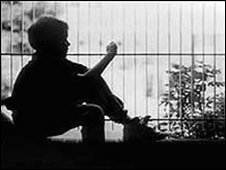
© BBCAutism is more often diagnosed in boys
The Institute of Child Health team says diagnosed children have severe versions of character traits probably shared by millions of others.The 8,000 child study found even these mild traits could impair development.
Boys - who make up the bulk of autism diagnoses - were most likely to be affected, the US journal study found.
Scientists have understood for some time that the "autistic spectrum" covers a wide range of children with differing levels of problems, from relatively mild cases to severely disabling problems.
However, a relatively small number of children - approximately 116 per 10,000 - are said to have an autistic disorder.
The UK research, published in the Journal of the American Academy of Child and Adolescent Psychiatry provides further evidence that the same traits do not begin and end there, but continue at into the whole population of children, just at a level which does not lead parents to seek medical help.
Seeing autism as a "distinct illness" was probably wrong, they said.
Even at this mild level, however, these characteristics - particularly problems communicating with peers and teachers - can be a disadvantage.
The findings confirmed that IQ was not an issue - the traits could be present regardless of levels of intelligence.
However, it cast some light on the differential in the numbers of boys and girls diagnosed with autism.
Girls with autistic traits appeared to be able to compensate for social communication problems if they had sufficient "verbal IQ" - a natural ability to use language well.
However, even boys with high "verbal IQ" seemed less able to overcome their communication problems.
Education awarenessProfessor David Skuse, one of the researchers involved, said the results did not downplay the genuine impact of more severe autism.
However, he added: "What this does suggest is that drawing a dividing line between those with autism and the rest of the population involves taking an arbitrary decision."
"Clinicians and those involved in education need to aware that there are children who do not have autism but who nevertheless have somewhat elevated levels of autistic traits - our research suggests that these children are at slightly greater risk of developing behavioural and emotional problems."
In an accompanying editorial, Professor John Constantino, from Washington University, said that the idea that autism represented the "severe end" of a natural distribution of abilities could help scientists looking for the genetics underlying the condition, or for ways to treat it.
It could also help the development of children who were affected, but not to the level of an autism diagnosis.
He wrote: "The approach of teachers and family members to such children can vary dramatically on the basis of the perceived origins of the behaviour, and recognition of the contribution of subthreshold autistic impairments can result in far more appropriate and supportive responses than typically occur when antisocial motives are presumed."

Comment: According to the above article the diagnosed children have severe versions of autism. Such cases, or so it seems, represent only the tip of the iceberg. What is usually overlooked, and this article seems to bring it to our attention, is that probably millions of others share the autistic impairments in a much milder form. This widespread of autistic traits may lead to increase of antisocial behaviours in adulthood. We can only speculate what the real impact of the widespread of autistic impairments on the society is and what is their cause, but the aluminum and mercury included in the vaccines seem to have a causal relationship as described here.